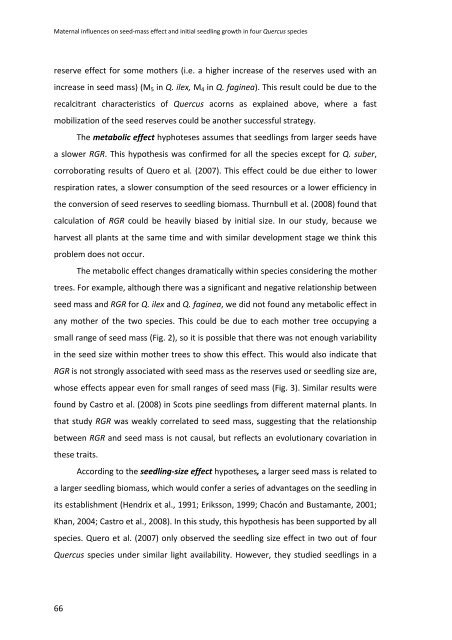Establecimiento de cuatro especies de Quercus en el sur de la ...
Establecimiento de cuatro especies de Quercus en el sur de la ...
Establecimiento de cuatro especies de Quercus en el sur de la ...
Create successful ePaper yourself
Turn your PDF publications into a flip-book with our unique Google optimized e-Paper software.
Maternal influ<strong>en</strong>ces on seed‐mass effect and initial seedling growth in four <strong>Quercus</strong> species<br />
reserve effect for some mothers (i.e. a higher increase of the reserves used with an<br />
increase in seed mass) (M 5 in Q. ilex, M 4 in Q. faginea). This result could be due to the<br />
recalcitrant characteristics of <strong>Quercus</strong> acorns as exp<strong>la</strong>ined above, where a fast<br />
mobilization of the seed reserves could be another successful strategy.<br />
The metabolic effect hyphoteses assumes that seedlings from <strong>la</strong>rger seeds have<br />
a slower RGR. This hypothesis was confirmed for all the species except for Q. suber,<br />
corroborating results of Quero et al. (2007). This effect could be due either to lower<br />
respiration rates, a slower consumption of the seed resources or a lower effici<strong>en</strong>cy in<br />
the conversion of seed reserves to seedling biomass. Thurnbull et al. (2008) found that<br />
calcu<strong>la</strong>tion of RGR could be heavily biased by initial size. In our study, because we<br />
harvest all p<strong>la</strong>nts at the same time and with simi<strong>la</strong>r <strong>de</strong>v<strong>el</strong>opm<strong>en</strong>t stage we think this<br />
problem does not occur.<br />
The metabolic effect changes dramatically within species consi<strong>de</strong>ring the mother<br />
trees. For example, although there was a significant and negative r<strong>el</strong>ationship betwe<strong>en</strong><br />
seed mass and RGR for Q. ilex and Q. faginea, we did not found any metabolic effect in<br />
any mother of the two species. This could be due to each mother tree occupying a<br />
small range of seed mass (Fig. 2), so it is possible that there was not <strong>en</strong>ough variability<br />
in the seed size within mother trees to show this effect. This would also indicate that<br />
RGR is not strongly associated with seed mass as the reserves used or seedling size are,<br />
whose effects appear ev<strong>en</strong> for small ranges of seed mass (Fig. 3). Simi<strong>la</strong>r results were<br />
found by Castro et al. (2008) in Scots pine seedlings from differ<strong>en</strong>t maternal p<strong>la</strong>nts. In<br />
that study RGR was weakly corr<strong>el</strong>ated to seed mass, suggesting that the r<strong>el</strong>ationship<br />
betwe<strong>en</strong> RGR and seed mass is not causal, but reflects an evolutionary covariation in<br />
these traits.<br />
According to the seedling‐size effect hypotheses, a <strong>la</strong>rger seed mass is r<strong>el</strong>ated to<br />
a <strong>la</strong>rger seedling biomass, which would confer a series of advantages on the seedling in<br />
its establishm<strong>en</strong>t (H<strong>en</strong>drix et al., 1991; Eriksson, 1999; Chacón and Bustamante, 2001;<br />
Khan, 2004; Castro et al., 2008). In this study, this hypothesis has be<strong>en</strong> supported by all<br />
species. Quero et al. (2007) only observed the seedling size effect in two out of four<br />
<strong>Quercus</strong> species un<strong>de</strong>r simi<strong>la</strong>r light avai<strong>la</strong>bility. However, they studied seedlings in a<br />
66

















